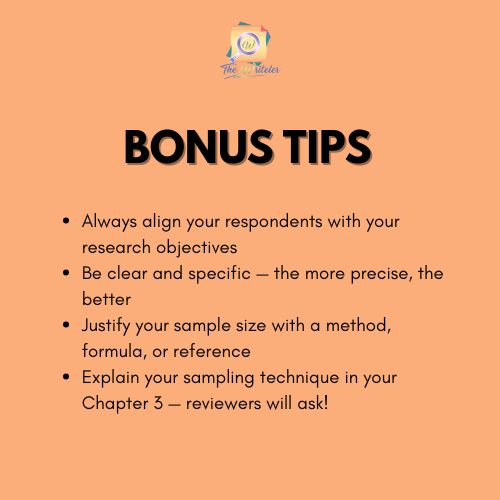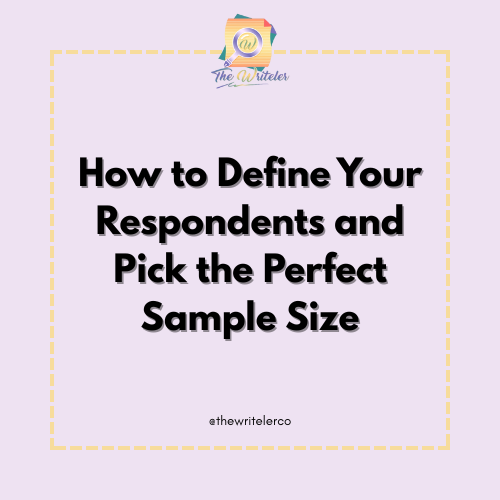When writing Chapter 3 of your research — the Methodology — one of the key questions you need to answer is:
“Who are you studying, and how many?”
Whether you’re doing a thesis, dissertation, or capstone, clearly defining your respondents and choosing the right sample size is essential for a credible and successful study. Sadly, this is also where many students fall into vague descriptions like “random people” or “some students” — which panelists can easily question or reject.
In this guide, we’ll walk you through how to properly define your respondents and determine a sample size that’s justified, realistic, and aligned with your research goals.
What Are Respondents in Research?
In simple terms, respondents are the people who will provide you with the data you need — usually by answering surveys, participating in interviews, or being observed.
They are not just “anyone available.” Your respondents must be:
- Clearly defined
- Relevant to your topic
- Able to contribute useful insights
Examples:
- Senior high school students enrolled in STEM strand
- Small business owners in Quezon City
- Public school teachers with at least 5 years of experience
How to Define Your Respondents Clearly
To avoid confusion and strengthen your research, follow these steps:
✅ 1. Identify Your Target Population
Start by determining who you want to study.
Ask: Who can best answer your research questions?
Example: If your study is about online learning, your respondents might be students or teachers actively involved in remote classes.
✅ 2. Set Inclusion and Exclusion Criteria
Be specific about who qualifies — and who doesn’t.
- Inclusion: Age, gender, education level, location, occupation
- Exclusion: People outside your scope (e.g., students from private schools if you focus on public ones)
Example: “Only Grade 12 students from public high schools in Laguna, enrolled in academic strands, will be included in this study.”
✅ 3. Justify Their Relevance
Don’t just choose people because they’re easy to access. Explain why they’re the best fit to provide the data for your variables.
“This group was selected because they are currently experiencing the challenges related to online education that the study aims to explore.”
Overview of Sampling Techniques
Once your population is clear, you need to decide how you’ll select your respondents. There are two main categories:
🎯 Probability Sampling
Best for quantitative studies where generalization is important. Each person has a known chance of being selected.
- Simple Random Sampling – everyone has equal chance
- Stratified Sampling – divided into subgroups (e.g., by strand or gender)
- Systematic Sampling – every nth person is chosen
- Cluster Sampling – entire groups (e.g., classes or schools) are selected randomly
🧠 Non-Probability Sampling
Common in qualitative research or limited-resource studies.
- Purposive Sampling – select based on characteristics relevant to the study
- Convenience Sampling – select those easiest to reach
- Snowball Sampling – current participants refer others
- Quota Sampling – ensure certain quotas are met per group
How to Determine the Perfect Sample Size
Choosing your sample size depends on your research type and design.
✅ 1. Match It to Your Study Type
- Quantitative studies require more respondents for statistical validity.
- Qualitative studies rely on data saturation — when no new information emerges.
Rule of thumb:
- Surveys: 30+ is often acceptable for small theses, but 100+ gives better results.
- Interviews: 6–15 participants are usually enough for saturation.
✅ 2. Use Sample Size Formulas (Quantitative)
One of the easiest ways is Slovin’s formula:
n = N / (1 + Ne²)
Where:
- n = sample size
- N = population size
- e = margin of error (e.g., 0.05 for 5%)
You can also use online tools like:
- Raosoft Sample Size Calculator
- G*Power (for more technical designs)
✅ 3. Consider Scope, Time, and Budget
Be realistic. A sample size of 300 sounds impressive — but only if you have the time, access, and resources to gather that many quality responses.
✅ 4. Check Similar Studies
Use past research as a benchmark. Many journals or local theses can guide you on appropriate sample sizes for your topic and setting.
Sample Statements for Chapter 3
Here’s how your explanation might look:
“The respondents of this study were 120 senior high school students from two public schools in Quezon City. Stratified random sampling was used to ensure representation from different academic strands. The sample size was determined using Slovin’s formula with a 5% margin of error.”
Or for qualitative:
“This study used purposive sampling to select 10 public school teachers who have been teaching online classes for at least two years. Data saturation was considered in determining the final sample size.”
Common Mistakes to Avoid
🚫 Saying “random people” without defining who and why
🚫 Choosing your friends or classmates just for convenience
🚫 Using a sample size without citing a formula or logic
🚫 Ignoring your study’s population, method, or objectives

📣 Need Help Defining Your Respondents or Calculating Your Sample Size?
The Writeler Co. is here to support students and professionals who are juggling research with work, life, and business. Whether you’re writing a thesis, capstone, or dissertation for your master’s or Ph.D., we help you efficiently navigate the research journey — from brainstorming to proofreading.
📩 Message us today to get started.
📚 Let’s turn your research idea into a powerful paper.





0 Comments